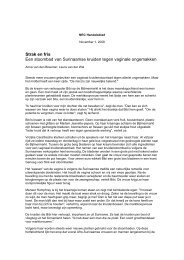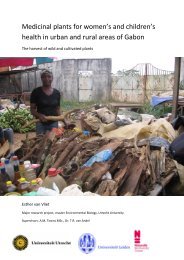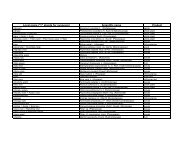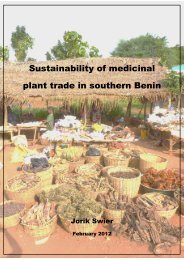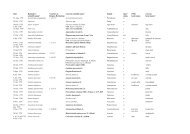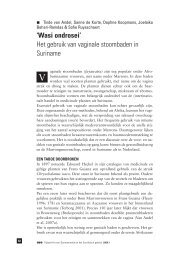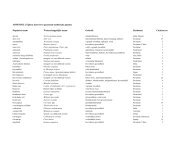T. Heilbron 2012.Botanical relics of the plantations - osodresie
T. Heilbron 2012.Botanical relics of the plantations - osodresie
T. Heilbron 2012.Botanical relics of the plantations - osodresie
You also want an ePaper? Increase the reach of your titles
YUMPU automatically turns print PDFs into web optimized ePapers that Google loves.
(a) Satellite image <strong>of</strong> abandoned<br />
and overgrown <strong>plantations</strong>,<br />
Warappa creek, Commewijne<br />
1.2.2 Legacy <strong>of</strong> <strong>the</strong> Plantations<br />
(b) An historical planter’s house<br />
on partly urbanized plantation Alliance,<br />
Commewijne<br />
Figure 2: Remnants <strong>of</strong> <strong>the</strong> <strong>plantations</strong> in Suriname<br />
(c) A kettle for boiling sugarcane<br />
syrup in <strong>the</strong> forest on plantation<br />
de Hoop, Commewijne<br />
In Suriname plantation history is still very well visible, both in abandoned and urbanized areas<br />
(See: Fig. 2). Remnants <strong>of</strong> <strong>the</strong> extensive coastal drainage system are visible on satellite images<br />
(2a), while on some former <strong>plantations</strong> <strong>the</strong> remains <strong>of</strong> buildings (2b) and various o<strong>the</strong>r remnants<br />
and artifacts can be found (2c). Fur<strong>the</strong>rmore, names like ‘Blauwgrond’ (Blueground in Dutch)<br />
for a former indigo plantation refer to historical links.<br />
There is growing interest in Suriname for conserving, protecting and restoring <strong>plantations</strong><br />
for educational and heritage tourism purposes. Organizations like Foundation for <strong>the</strong> Protection<br />
<strong>of</strong> Antiquities Suriname (STIBOSUR), The Built Heritage Foundation Suriname (SGES)<br />
and restoration projects on former <strong>plantations</strong> Reijnsdorp (http://www.warappakreek.com),<br />
Peperpot (http://plantagepeperpot.nl) and Frederiksdorp (http://www.frederiksdorp.<br />
com) are examples <strong>of</strong> this.<br />
Most archaeological research in Suriname has focused on <strong>the</strong> indigenous population (e.g.<br />
Versteeg, 1998, 1992). Little research on <strong>the</strong> <strong>plantations</strong> and plantation era (roughly 1667-1873)<br />
has taken place. One exception is <strong>the</strong> search for fort Buku, <strong>the</strong> stronghold <strong>of</strong> Boni, one <strong>of</strong> <strong>the</strong><br />
most famous maroons fighting against colonial authority in Suriname (Pel et al., 2008). Still, no<br />
scientific research has been done on <strong>the</strong> botanical heritage <strong>of</strong> <strong>the</strong> plantation society.<br />
1.2.3 Plants <strong>of</strong> <strong>the</strong> Plantations<br />
There are a limited number <strong>of</strong> 17 th and 18 th century historical accounts that provide some information<br />
on <strong>the</strong> plants present on <strong>the</strong> <strong>plantations</strong> in Suriname. Important are <strong>the</strong> recently rediscovered<br />
diary <strong>of</strong> Linnaeus-trained botanist Daniel Rolander, who mentioned plants from <strong>the</strong><br />
gardens <strong>of</strong> slaves, such as Cleome gynandra L. used as a vegetable and Croton tiglium L. used<br />
medicinally (Rolander, 2008). O<strong>the</strong>r sources are <strong>the</strong> drawings <strong>of</strong> Maria Sibylla Merian (1705),<br />
<strong>the</strong> collections <strong>of</strong> Gustav Dahlberg (1771), <strong>the</strong> Hermann herbarium (Van Andel et al., in press)<br />
and historical descriptions <strong>of</strong> <strong>the</strong> colony (Herlein, 1718; Fermin, 1765; Hartsinck, 1770). Apart<br />
from obvious cash crops, African crops were brought as ‘local known’ food for <strong>the</strong> slaves as<br />
provisions on <strong>the</strong> Trans-Atlantic journey (Emmer, 2007). The more recent literature that covers<br />
plantation crops in Suriname dates from <strong>the</strong> 1960s (e.g. Ostendorf, 1962; Wessels Boer, 1965).<br />
5



